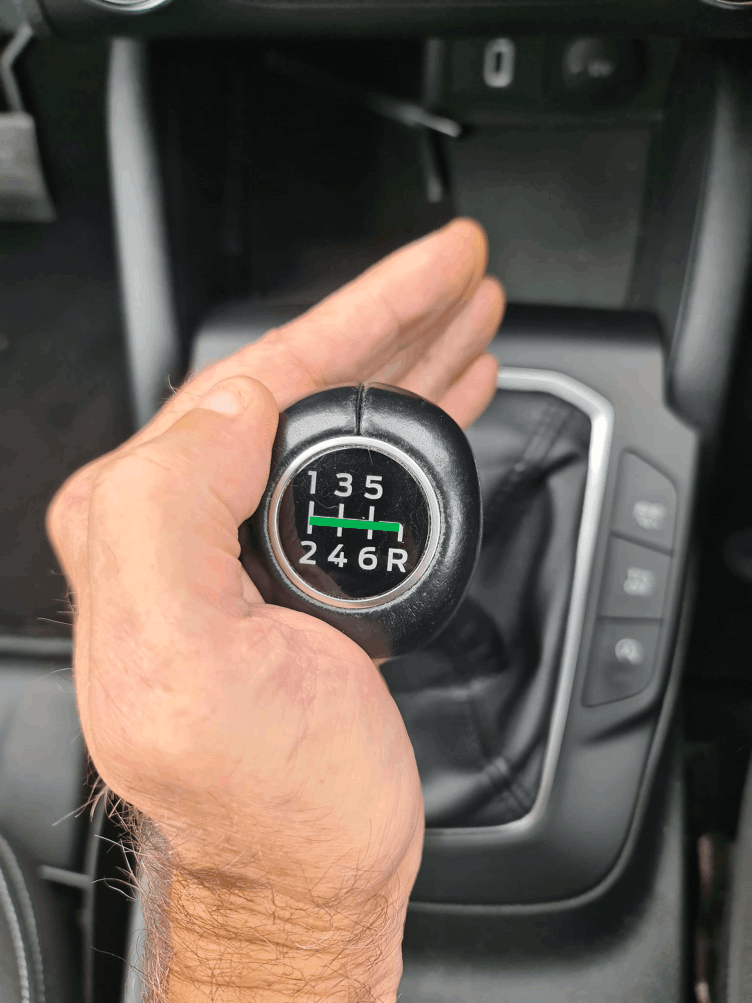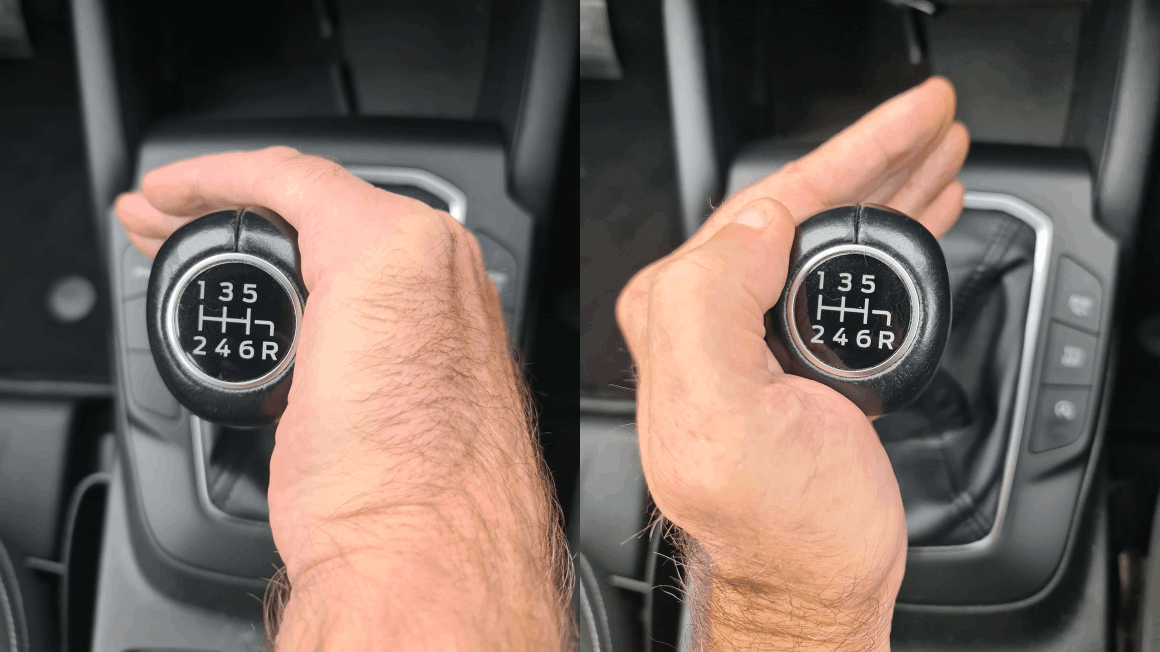Neutral
Neutral on a gear lever as shown by the green line in the picture.
Is the position selected before starting a car.
We do this so that when the engine is started the car will not move in any direction.
When the gears are in neutral it means that no gear has been selected, therefore no drive can be made between the engine to the gearbox to the wheels.
This is the safest way to start a car to avoid any unnecessary movement .
It is very easy to know whether Neutral is selected, by moving the lever from left to right.
If there is lots of sideways movement you will be in Neutral.
If a gear is selected there is hardly any movement from side to side.
When the Gear lever is in Neutral and not held onto, the lever will naturally sit in between 3rd and fourth gear along the neutral line. This means that to select 1st or second gear you must move the lever to the left, and then either forwards toward the front of the car for 1st gear, or backwards toward the rear of the car for 2nd gear.
3rd gear would be forward from the neutral position
4th gear would be backward from the neutral position
5th gear would be right and forward from the neutral position
6th gear would be right and backward from the neutral position.
Reverse gear is shown by the use of the letter R and may be in different locations depending on what gearbox has been fitted. This tends to change from manufacturer to manufacturer.
When selecting ANY gear the Clutch MUST be fully pressed to the floor. By not pressing the Clutch you risk either jumping into gear and the car will jolt in the direction of the gear selected with a possible stall outcome or you risk damaging the gearbox and you will get a nasty grinding noise as the gears crunch against each other.
If at any time a gear is selected prior to starting the engine and your foot is off the clutch the car will want to move, this is why it is so important before starting the car that is in Neutral or the clutch is fully depressed before turning the engine on.
When changing gear, ease off the gas pedal, depress the Clutch to the floor, select the gear you need, slowly raise the Clutch and finally re-apply the gas.
By using this method every time you change gear, the transition between each gear will be smooth and controlled.
Use of the correct gear and effective use of the clutch will allow for smooth transitions between each gear.
In 1st gear from stationary the clutch MUST be raised gently to allow the car to gain some momentum before releasing the clutch fully.
From 1st to 2nd gear the time to release the clutch is still controlled but nowhere near as slow as it will need to be from moving off in 1st.
All the other gear changes do not necessarily need to be slow releasing the clutch pedal as the car has enough momentum to not cause any issues with stalling or jumpiness.
1st gear provides the greatest force to the wheels and is normally the one you use to get the vehicle moving. If you were pointing downhill you could possibly use 2nd or even 3rd depending on the gradient, as you could select the higher gear, carry out your safety checks visually and the release the parking brake. The car will naturally begin to roll because of the gradient and once you have achieved enough speed to not allow the car to stall you could gradually come off the clutch to engage drive to the wheels from the engine.
The higher the gear you use, the less fuel you use. But you need to have an appropriate speed for the gear that you are using.
Gears can be extremely beneficial when going up hill or downhill if used correctly.
One of the biggest misconceptions with learners and gear use, is that they firmly believe the higher the gear used the more power the car has.
This is in part correct but not where hill are concerned.
If you were going up a steep gradient, gravity and the gradient will begin to slow your car down. If you had started at the bottom of the hill in a high gear, it is inevitable that the car will soon begin slowing because of the gradient and gravity. If you were to leave this gear selected, the car will just get slower and slower until the car either started jumping or came to a complete standstill and an avoidable stalling situation.
Because 1 st has the most force at the wheels, and the higher you go up through the gear the less that force gets, it means that when you are going uphill and you car begins to slow down, you will need to come back down the gears according to how slow the car gets.
If we put gears in their most basic understanding for new drivers, we would say
1st gear is use from
Zero speed - 10mph
2nd is used from 10mph - 20mph
3rd is used from 20mph - 30mph
4th is used from 30mph - 40mph
5th is used from 40mph - 50mph
and 6th is used from 50mph upwards.
That really is putting a very bland line on how gears work, but it will give you a better understanding, that as per the example above of starting at the bottom of the hill in a speed that warranted 6th gear, it would mean that you were probably doing somewhere between 50-70mph.
But the hill is long and steep and the gradient and gravity begins to slow your car. By the time your speed has dropped to 40mph, you'll probably be needing to be back in 4th gear, and if the car continues to slow and slow and slow, you could even end up with your car being back in 1st gear just to get you to the top of the hill.
Had you continued to keep the car in 6th gear thinking it has the most amount of power to get you up the hill, you would be totally wrong and you would end up with a stalled car for sure.
Likewise, coming down hill.
By utilising the gears in the correct manner, it will stop your car from running away with you, and the constant need to keep braking to slow the car down.
In 6th gear the car wants to do speeds upwards of 50mph, but in 1st gear it wont want to do much more than 10mph.
Therefore, if you are coming downhill and you find you need to keep pressing the brake pedal to stop the car running away with you, them come down a gear. If the car continues to keep running away with you, then drop down another gear and so on until you might end up back in 1st gear.
By utilising the gear to keep your speed slow, it will avoid the need to keep using the brake pedal.
Constant use of the brakes in a short period of time will cause what is known as brake fade.
Brake fade (or vehicle braking system fade) is the reduction in stopping power that can occur after repeated or sustained application of the brakes of a vehicle, especially in high load or high speed conditions.
Brake fade can be a factor in any vehicle that utilizes a friction braking system including cars, trucks, motorcycles, airplanes, and bicycles.
Brake fade is caused by a buildup of heat in the braking surfaces and the subsequent changes and reactions in the brake system components and can be experienced with both drum brakes and disc brakes. Loss of stopping power, or fade, can be caused by friction fade, mechanical fade, or fluid fade. Brake fade can be significantly reduced by appropriate equipment and materials design and selection, as well as good cooling.
Brake fade occurs most often during high performance driving or when going down a long, steep hill.
It is more prevalent in drum brakes due to their configuration.
Disc brakes are much more resistant to brake fade because the heat can be vented away from the rotor and pads more easily, and have come to be a standard feature in front brakes for most vehicles.





